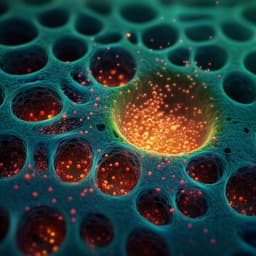
Engineering and Technology
Electrodeposition of porous metal-organic frameworks for efficient charge storage
D. B. Bailmare, B. V. Malozyomov, et al.
This study showcases a groundbreaking electrodeposition technique that enhances the energy efficiency and electrochemical yield of supercapacitors. Conducted by Deepa B. Bailmare, Boris V. Malozyomov, and Abhay D. Deshmukh, this innovative method results in an asymmetric supercapacitor with remarkable stability, setting a new standard for charge storage solutions.
~3 min • Beginner • English
Introduction
Charge storage underpins batteries, supercapacitors, and sensors, but conventional carbon and metal oxides face trade-offs among surface area, conductivity, energy density, and rate capability. While carbon-based materials offer high electrochemical performance and stability, achieving simultaneously high energy density and chemical stability remains challenging. Metal-organic frameworks (MOFs) provide high surface area, tunable pore size, and diverse chemistries with potential electrical conductivity and redox activity via judicious selection of metal centers and organic linkers. However, conventional MOF syntheses (solvothermal/hydrothermal) often require harsh conditions, long times, and yield reproducibility issues, limiting practical deployment. Chronoamperometric electrodeposition has emerged as a promising route to fabricate conductive, porous MOF films directly on conductive substrates with controllable morphology and thickness. This study investigates electrodeposition of a porous Co-MOF on Ni foam, elucidates nucleation/growth kinetics, and evaluates charge storage in three-electrode and asymmetric two-electrode supercapacitor configurations. The work aims to demonstrate scalable synthesis with excellent capacitance and cycling stability and to benchmark against literature.
Literature Review
The paper situates MOFs within energy storage materials, citing prior advances in MOF-based electrodes and their derivatives, and highlighting the need for improved synthesis control and stability. It references theoretical models for nucleation and growth (Scharifker–Hills) and prior reports on Co(OH)2- and MOF-based supercapacitor performance, including typical voltage windows, capacitances, and cycling stability in alkaline electrolytes. Compared literature comparisons (Table 1) show a range of specific capacitances (531–2564 F/g) and cycling stabilities (67–98%) for various MOF chemistries and syntheses, positioning the present electrodeposited Co-MOF/NF among high performers, especially at elevated current density.
Methodology
- Materials: Cobalt nitrate hexahydrate (Co(NO3)2·6H2O), 1,2-benzene dicarboxylic acid (BDC), DMF, and deionized water (DDH2O), all used as received.
- Substrate preparation: Nickel foam (NF) was cleaned mechanically (DI water rinse, gentle brushing) and chemically (ultrasonication in 0.1 M HCl for 10 min), rinsed thoroughly, and vacuum-dried at 80°C.
- Precursor solution: Co(NO3)2·6H2O (15 mM) and BDC (10 mM) dissolved in DMF:DDH2O (1:1), stirred 10 min for homogeneity.
- Electrodeposition setup: Three-electrode cell with NF working electrode, Pt foil counter, and Ag/AgCl reference. Chronoamperometry at a constant potential of −1.57 V vs Ag/AgCl for 300 s to grow Co-MOF directly on NF (Co-MOF/NF).
- Nucleation and growth analysis: Current–time (I–t) transients recorded and analyzed using the Scharifker–Hills model. Dimensionless analysis with I/Imax vs t/tmax compared to theoretical instantaneous vs progressive nucleation expressions, indicating behavior closest to instantaneous nucleation, with deviations after t/tmax > 1 attributed to side reactions and substrate surface heterogeneities.
- Proposed electrochemical reactions (abbrev.): Co2+ + 2e− → Co0; nitrate reduction leading to OH− generation; ligand deprotonation; Co–BDC coordination to form MOF crystallites; four-stage growth mechanism: nucleation, growth on substrate, intergrowth, and (undesired) detachment.
- Structural and compositional characterization: XRD (RIGAKU Miniflex 300/600) to determine crystallinity/phase; FTIR (Bruker) for functional groups; SEM/EDS (JEOL JSM 7617 F with Oxford EDS) for morphology and elemental composition/mapping.
- Electrochemical characterization (three-electrode): 1 M KOH electrolyte; CV in 0.0–0.5 V at 10–100 mV/s; GCD at 4–20 A/g; electrochemical impedance spectroscopy (EIS) 0.01–10000 Hz; analysis of capacitive vs diffusion contributions via power-law (ip = a v^b) and Dunn’s method (i(v) = k1 v + k2 v^1/2); Bode/impedance-derived C′(ω), C″(ω), and relaxation time.
- Asymmetric two-electrode device assembly: Positive electrode: Co-MOF/NF (pressed onto NF at 10 MPa for 10 s). Negative electrode: Activated Carbon Cloth (ACC), 0.5 × 0.5 cm, binder-free. Separator: Celgard 3501. Electrolyte: 1 M KOH. Mass balancing guided by standard charge balance relation. Device tested via CV (0–1.2 V), GCD at various current densities, cycling (up to 50,000 cycles), EIS (Nyquist). Practical demonstration by powering 37 yellow LEDs with three devices in series.
- Instruments: Electrochemical tests on Metrohm 128 N Autolab; cycling on LABstation battery testing system.
Key Findings
- Electrodeposition kinetics: Chronoamperometry I–t transients fit Scharifker–Hills instantaneous nucleation better than progressive; deviations after t/tmax > 1 indicate side reactions and extra-active nucleation sites.
- Structure/composition: XRD shows highly crystalline Co-MOF, matching CCDC 4501569 (triclinic, space group P-1, Z = 2). EDS: Co 40.8 wt%, C 17.4 wt%, O 8.9 wt%. FTIR confirms OH, COO−, metal–carboxylate, and linker-related vibrations; functional groups support redox activity and ion selectivity. SEM: agglomerated, porous nanostructures distributed over Ni foam, suggesting high surface area and interconnected framework.
- Three-electrode electrochemistry (Co-MOF/NF in 1 M KOH, 0–0.5 V):
- CV shows redox peaks at ~0.25 V and ~0.40 V, indicative of Co-based pseudocapacitance.
- GCD exhibits pseudocapacitive plateaus; maximum specific capacitance 1618.56 F/g at 4 A/g.
- Energy/power: 56.2 Wh/kg at 1000 W/kg, retaining 28.94 Wh/kg at 4999.12 W/kg.
- Kinetics: Power-law b ≈ 1.02, indicating dominant capacitive behavior. Dunn’s analysis: at 10 mV/s, 53% diffusion vs 47% capacitive; capacitive fraction rises to 82% at 100 mV/s.
- EIS: Low ESR and Rct qualitatively; Bode phase angle up to ~80°, indicating high capacitive behavior; relaxation time constant τ ≈ 3.44 s.
- Cycling stability: 97% capacitance retention over 5000 cycles at 6 A/g.
- Asymmetric device (Co-MOF/NF // ACC, 1 M KOH, 0–1.2 V):
- CV shows combined EDLC+pseudocapacitive behavior across scan rates.
- GCD: Specific capacitance 315.33 F/g at 0.2 A/g.
- Ragone: Energy density 63.06 Wh/kg at 479.94 W/kg.
- EIS (device): Series resistance ~1.36 Ω; charge transfer resistance ~5.42 Ω.
- Long-term cycling: 99.6% capacitance retention over 50,000 cycles.
- Demonstration: Three ASCs in series (≈3 V) powered 37 yellow LEDs.
- Benchmarking: Compared with literature (Table 1), the electrodeposited Co-MOF/NF shows competitive/high capacitance and superior cycling stability, particularly at higher current density.
Discussion
The study addresses the need for scalable, controllable synthesis of high-performance MOF electrodes by leveraging chronoamperometric electrodeposition to directly grow a porous Co-MOF on conductive Ni foam. Instantaneous-like nucleation and intergrown crystallite networks yield high-accessibility redox sites and rapid ion transport, translating into high gravimetric capacitance, good rate handling, and excellent stability. The strong capacitive character (b ≈ 1), increasing capacitive contribution with scan rate, low impedance, and short relaxation time support fast charge storage kinetics. In practical asymmetric cells paired with ACC, the broader voltage window (0–1.2 V) enables high energy density while maintaining low internal resistance and exceptional cycle life (99.6% over 50k cycles). Literature comparisons indicate that electrodeposition can rival or surpass hydrothermal/solvothermal routes in performance while offering finer control over film thickness and functionality. These findings underscore electrodeposition as a promising pathway for integrating MOF electrodes into high-power, long-life energy storage devices.
Conclusion
This work demonstrates a binder-free Co-MOF electrode grown directly on Ni foam via chronoamperometric electrodeposition, achieving high capacitance (1618.56 F/g at 4 A/g), strong rate performance, and excellent cycling stability (97% over 5000 cycles) in three-electrode tests. In an asymmetric Co-MOF/NF // ACC device (0–1.2 V), the cell delivers 315.33 F/g and 63.06 Wh/kg at 479.94 W/kg, with exceptional durability (99.6% retention over 50,000 cycles), and powers an LED array, highlighting practical viability. The synthesis strategy offers controllable morphology and thickness, improved electroactive site utilization, and low interfacial resistances. Future research could explore: expanding to other metal centers/linkers for optimized conductivity/redox activity; systematic tuning of deposition parameters for morphology–performance relationships; scaling to larger-area electrodes and pouch-cell formats; and stability in diverse electrolytes and operational environments to enable broader applications.
Limitations
- The SH model fitting shows notable deviation after t/tmax > 1, attributed to side reactions and substrate surface heterogeneities; this may impact precise extraction of nucleation parameters.
- The detachment phase in MOF growth is identified as undesirable; while avoided under chosen conditions, its onset limits process windows for high-quality deposition.
- Performance is demonstrated in alkaline aqueous electrolyte (1 M KOH) with Ni foam and ACC; generalizability to other electrolytes, substrates, and full-device formats is not evaluated here.
- While impedance is low and stability high, detailed areal capacitance and long-term self-discharge/leakage assessments are not reported in the main text.
Related Publications
Explore these studies to deepen your understanding of the subject.







